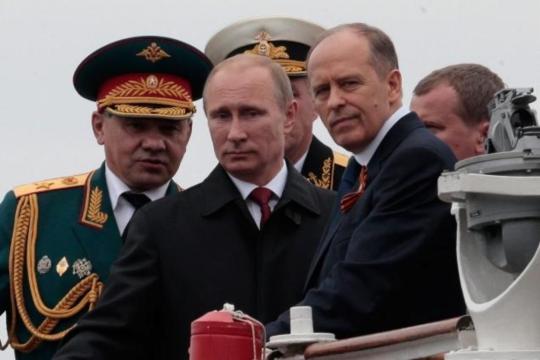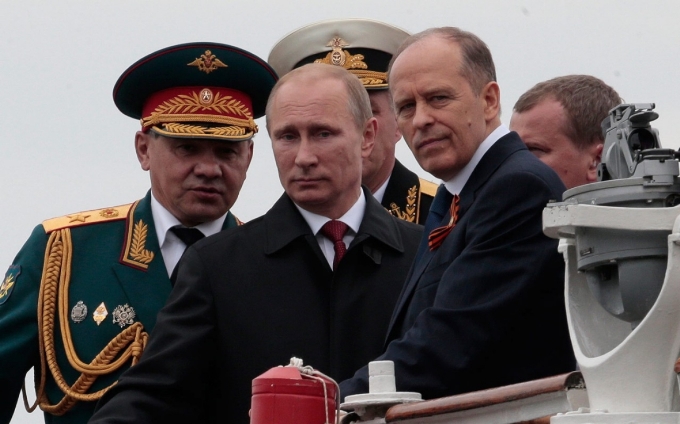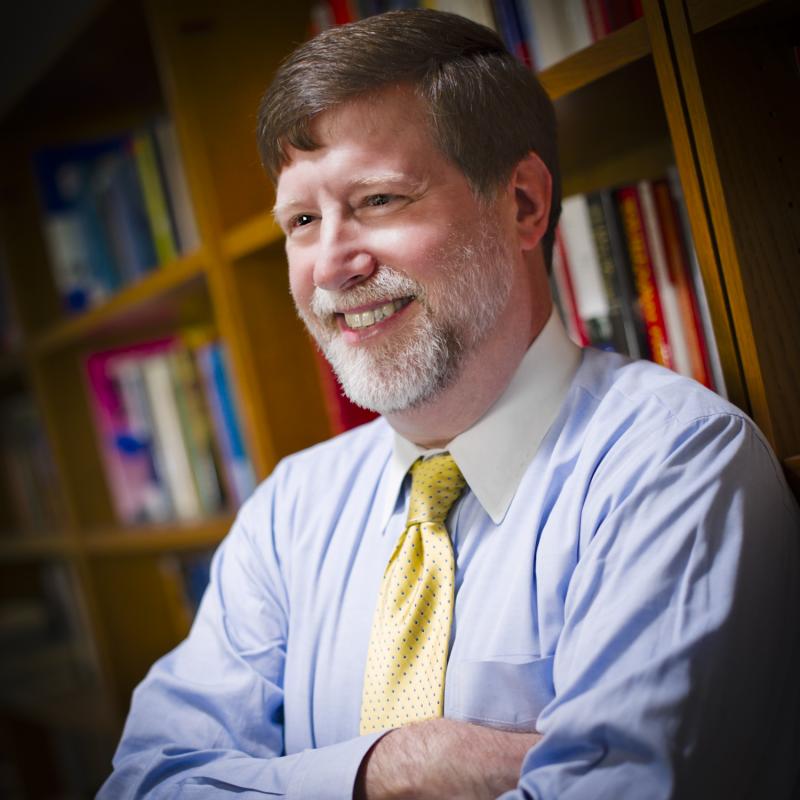
 |
| Russian President Vladimir Putin, flanked by Defence Minister Sergei Shoigu and Federal Security Service Chief Alexander Bortnikov, inspect battleships during victory day in Sevastopol [AP] |
| Abstract NATO’s lack of response to the Russian annexation of Crimea in 2014 and Russian support for separatist forces in eastern Ukraine since then has raised doubts about the effectiveness and durability of the Atlantic alliance. It is not clear how NATO would respond to Russian military activity elsewhere in Ukraine or in the Baltic states. On the other hand, undertaking such activity could prove both risky and costly for Moscow. |
Introduction
There is an old adage about alliances that goes something like this: When the purpose of an alliance comes to an end, the alliance itself comes to an end.
This adage has proven true on numerous occasions. The NATO alliance, though, seems to have defied this adage.
After the collapse of USSR when Moscow became much less of a threat, NATO not only survived, but expanded.
And ironically, while the Russian seizure and annexation of Crimea in 2014 as well as support for secessionists and even intervention in eastern Ukraine has greatly increased Western perceptions of Russia as a threat, these have not served to strengthen NATO but to increase strife within the alliance about how to respond to Russia as well as to heighten angst over the lack of an effective response. Further, there are now greater Western concerns about how the ineffectiveness of the NATO response to Russian action in Ukraine might encourage aggressive Russian action elsewhere, including against the three Baltic states (which had been part of the Soviet Union, became independent in 1991, and joined NATO as well as the European Union in 2004).
The crisis over Ukraine, then, is not simply about the future of that country or about Putin’s ultimate aims there or more broadly. It has also brought about something of an identity crisis for NATO. What is the purpose of the alliance?
Do all its members see Russia as a threat? Even if they do, what are they prepared to do about it? Indeed, is NATO as a whole prepared to do much of anything? Just through his actions in Ukraine raising these questions, Putin has brought into focus NATO’s internal contradictions which could be overlooked before the Ukrainian crisis but which cannot be now.
The Purpose of the Alliance: Differing Western Views
The problem for NATO is that there are many different views within it about what the purpose of the alliance actually is. During the Cold War, it was said that the purpose of the alliance was, in the words of the first NATO secretary general, Lord Ismay, ‘to keep the Russians out, the Americans in, and the Germans down.’(1) There were, of course, serious differences within NATO even then. Some doubted just how strongly America was committed to Western Europe’s defense (‘Would the U.S. risk New York in order to protect Paris?’), and some—especially the French—resented America’s predominant role in the alliance. A chronic source of annoyance for Washington was that while it wanted its European allies to spend more on their own defense, many of them were unwilling to do so. Even though they may have regarded Moscow as a threat, many saw the U.S. security commitment to Europe as sufficient to allow European governments to ‘free ride’ on America; since the richer, more powerful U.S. was expending its resources to defending them anyway, many Western European governments felt that they did not need to do all that much themselves.
With the end of the Cold War and the collapse of the Soviet Union, even greater variation developed concerning what the purpose of NATO was to be. Some such as Poland and the three Baltic states genuinely saw Russia as a continuing threat, and thus they saw a primary benefit of NATO membership as providing them protection against Russia.
Yet even for these countries—as well as others in Eastern Europe which either were not as worried or became less concerned about a potential Russian threat—a prime benefit of NATO membership was that this—as well as EU membership—was a visible sign that they had joined the West and would thus share in all the benefits that this entailed, including prosperity, rule of law, peaceful relations with other NATO and EU members, and a special relationship with Washington.
Many of NATO’s older members in Western Europe became far less concerned, or even unconcerned, about a threat from Russia after the end of the Cold War, but they saw NATO’s continuation as advantageous for several reasons: its expansion into Eastern Europe and the Baltics would serve to socialize these new members into Western ways as well as minimize the potential for conflict among them (which, as what happened in the former Yugoslavia showed, was a legitimate concern), and to keep America interested in and committed to European security—a concern that was especially strong among those (both in Eastern and Western Europe) worried about the implications of German reunification. Continued adherence to NATO was also seen as an important way to maintain close cooperation with the United States. And there were even those which shared Washington’s more expansive view of NATO playing a role outside its traditional theater of operations in Europe.
Washington saw NATO’s continuation as an important means for maintaining stability in Western Europe and expanding that stability into Eastern Europe, as well as for maintaining America’s leadership role.
Finally, it must be said that old, new, and aspiring NATO members never seriously considered disbanding the alliance. Why disband something that was serving the interests of all involved, even if there was a significant degree of variation among their interests? Indeed, the real question seemed to be just how far NATO should further expand. Existing NATO members were divided on this, but what was clear was that certain pro-Western leaders in Ukraine and Georgia in particular sought to join NATO both for protection against Russia as well as for the other benefits of joining their countries to the West.
Putin’s View and the Western Response
This, of course, was not how Putin saw the matter. He saw the only reason for NATO’s continued existence, and especially its expansion, as being to contain, constrain, and even invade Russia.(2) Pronouncements by Western leaders about how the expansion of NATO was not directed at Russia were simply dismissed by Moscow, which ‘knew better’. Many in Moscow also claim that at the end of the Cold War, American and Western officials ‘promised’ Moscow that NATO would not expand. But, in fact, no explicit promise or agreement to this effect was actually made.(3)
In 2008, part of Moscow’s motivation for intervening in Georgia was to forestall its president’s efforts to join NATO through making its membership unpalatable to Western European states. Indeed, the Georgian president himself appears to have behaved somewhat aggressively himself on the presumption that NATO would come to Georgia’s rescue in case of conflict with Russia.(4)
But matters came to a head in early 2014 in Ukraine, about which Moscow is particularly sensitive. While regretting the collapse of the Soviet Union generally, Russian nationalists particularly bewail the loss of Ukraine, most of which (i.e., not the far western area Stalin added to Ukraine when he redrew Eastern Europe’s borders at the end of World War II) they regard as an integral part of Russia. The loss of Crimea in particular they never accepted because 1) of the large Russian population resident there; and 2) after the Russian Revolution, Crimea was part of the Russian Federation until 1954 when Khrushchev transferred it to Ukraine to mark the 300th anniversary of the union between Russia and Ukraine. This did not matter when the Soviet Union was still intact.(5) Very soon after it broke up in 1991, though, Russian nationalists began calling for its return to Russia.
The government in Ukraine was largely pro-Russian from independence until 2004. Much to Putin’s fury, a pro-Western government came to power as a result of the ‘Orange Revolution’ that year, but this was voted out in 2010 when a pro-Russian leader was elected president. But after this man, Yanukovich, abruptly canceled his plans to sign an association agreement between Ukraine and the EU at the end of 2013, disappointed citizens began demonstrating against him. Although able to keep control at first, he apparently lost his nerve and fled to Russia in early 2014 and was replaced by a pro-Western government. It was then that Putin moved to annex Crimea, citing the possibility of Ukraine joining NATO as a reason to prevent this territory in particular—home of the Russian Black Sea fleet even when Crimea belonged to Ukraine—as an important reason in addition to what he claimed was overwhelming popular demand in Crimea to rejoin Russia.(6)
It was Putin’s quick, largely bloodless takeover and annexation of Crimea that upset NATO. If he could get away with this in Crimea, what would prevent him from doing something similar anywhere else where there was a Russian population in a non-Russian republic that he decided needed rescuing? The rise of Russian separatist forces in eastern Ukraine, as well as Putin’s own claims to a historic region known as ‘Novorossiya’ (i.e., all of southeastern Ukraine, including most of its Black Sea coast) raised Western concerns further.(7) Yet while virtually all Western governments objected to what Putin had done, it soon became clear that few were willing to do much of anything about it beyond imposing economic sanctions—and some were distinctly unenthusiastic about that.
Putin was able to win in Crimea and conclude that crisis quickly since neither the Ukrainian government nor the pro-Ukrainian population in Crimea fought against the Russian takeover. The conflict in eastern Ukraine, though, has not been settled. Ukrainian government forces, as well as Ukrainian nationalists, have been fighting against pro-Russian secessionist forces. Troops from Russia itself prevented the latter from being defeated, but conflict continues. Thousands of Russian troops are believed to have died or been wounded in the fighting—a subject that Moscow is so worried about that it does not allow public discussion of in Russia.(8)
Calls arose in Washington in particular for the U.S. and other Western governments to provide arms to the Ukrainian government in order to resist further Russian advances. Many Western observers and West European government officials, though, warned against this, arguing that Russia was in a stronger position to escalate conflict in eastern Ukraine and expressing fear that conflict could spread not just throughout Ukraine, but into other areas of Europe.(9)
Going Forward
Ukraine, of course, is not a NATO member, and so NATO is not obliged to defend it. There is fear, though, that Putin might decide to ‘rescue’ Russians living close to the Russian border in Estonia and Latvia, which are NATO members. Putin might do this either if he decides that he has been successful in eastern Ukraine and so can do the same elsewhere, or out of frustration at not being successful in eastern Ukraine and so decides to strike out in the Baltics. Either way, he may anticipate that most NATO countries will not be willing to fight in defense of the Baltic states, and will thus render NATO useless. For their part, several Western European governments worry simultaneously that the U.S. will do too much in Ukraine (thus dragging them into an expanded conflict) but also that the U.S. will do too little there and in the Baltics (thus leaving the Europeans to deal on their own with Putin). Many are now focusing more on the flood of migrants from Syria and North Africa flowing into their countries than on what Russia is doing in seemingly faraway eastern Ukraine. The Obama Administration, for its part, does not want to see Putin expand further, but it does not want to get involved in conflict with it either—especially if the European allies are not going to join in. And all this is going on at a time when Washington is increasingly being distracted from its concerns about Russia by growing threats from China, North Korea, and ISIS.
It is not at all clear, of course, that Putin will actually support or directly undertake military action elsewhere in Ukraine, or against the Baltics. Both, after all, involve serious risks for Moscow. Even if NATO does not do much more than what it is already doing in Ukraine, expanded military action there risks getting Moscow bogged down in a quagmire against an increasingly nationalist Ukrainian government and public. Undertaking military action against the Baltics risks a direct military confrontation with NATO—a high potential cost for Moscow. At the very minimum, additional Russian military actions elsewhere in Europe are likely to result in further Western economic sanctions against Moscow. Perhaps the greatest threat to Putin of expanded conflict is increased Russian casualty levels that cannot be hidden from the Russian public which could undermine his domestic support. A prudent Putin would not risk this.
But Putin may not be prudent. He could expand Russian (or Russian-supported) military action in Ukraine, or even initiate it in the Baltics. Although not clear how NATO will respond, some things can be foretold: 1) there will be different opinions among the NATO members about what to do; 2) those NATO members more willing to confront Russia will formulate the response while those less willing may or may not contribute to it, but none will actively stand in the way of its implementation; 3) NATO may not stop Russian military activity, but NATO (along with the EU) will impose heavy costs on Moscow for undertaking this; 4) America and other NATO member governments will call upon their non-NATO allies (including ones in the Gulf) to dramatically curtail their cooperation with Russia; and above all 5) NATO will not disband at the behest of or under pressure from Vladimir Putin. Even if NATO’s response is muddled, the purpose of the alliance will be much clearer than it has been in recent years.
___________________________________________
Mark N. Katz (Ph.D.) is Professor of Government and Politics at George Mason University (USA) and has been writing about Soviet and Russian foreign policy for over three decades.
References
(1) O. Manea (2010) ‘Lord Ismay, Restated’, Small Wars Journal blog, 18 November, http://smallwarsjournal.com/blog/lord-ismay-restated .
(2) F. Hill and C.G. Gaddy (2015) Mr. Putin: Operative in the Kremlin (Washington, DC: Brookings Institution Press), pp. 261-3.
(3) M.E. Sarotte (2014) ‘A Broken Promise? What the West Really Told Moscow About NATO Expansion’, Foreign Affairs, September/October, https://www.foreignaffairs.com/articles/russia-fsu/2014-08-11/broken-promise .
(4) SPIEGEL Staff (2008) ‘Did Saakashvili Lie? The West Begins to Doubt Georgian Leader’, SPIEGEL Online, 15 September, http://www.spiegel.de/international/world/did-saakashvili-lie-the-west-begins-to-doubt-georgian-leader-a-578273.html .
(5) K. Calamur (2014), ‘Crimea: A Gift to Ukraine Becomes a Political Flash Point’, National Public Radio, 27 February, http://www.npr.org/sections/parallels/2014/02/27/283481587/crimea-a-gift-to-ukraine-becomes-a-political-flash-point .
(6) V. Putin (2014) ‘Address by President of the Russian Federation’, President of Russia website, 18 March, http://en.kremlin.ru/events/president/news/20603 .
(7) A. Taylor (2014) ‘”Novorossiya”, the Latest Historical Concept to Worry about in Ukraine’, Washington Post, 18 April, https://www.washingtonpost.com/news/worldviews/wp/2014/04/18/understanding-novorossiya-the-latest-historical-concept-to-get-worried-about-in-ukraine/ .
(8) P.R. Gregory (2015) ‘Russia May Have Inadvertently Posted Its Casualties in Ukraine: 2,000 Deaths, 3,200 Disabled’, Forbes.com, 25 August, http://www.forbes.com/sites/paulroderickgregory/2015/08/25/kremlin-censors-rush-to-erase-inadvertent-release-of-russian-casualties-in-east-ukraine/ .
(9) M.N. Katz (2015) ‘Russian Policy toward Ukraine: The View from Paris’, Travels and Observations blog, 16 March, https://katzeyeview.wordpress.com/2015/03/16/russian-policy-toward-ukraine-the-view-from-paris/, and M.N. Katz (2015) ‘Russian Policy toward Ukraine: The View from Berlin’, Travels and Observations blog, 17 March, https://katzeyeview.wordpress.com/2015/03/17/russian-policy-toward-ukraine-the-view-from-berlin/ .
